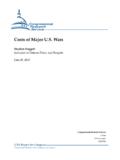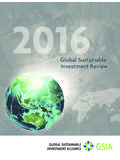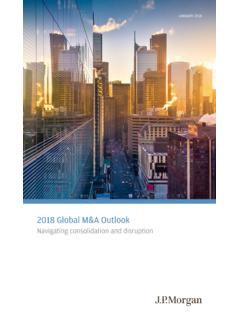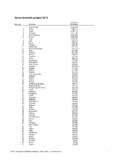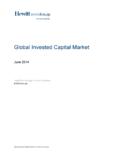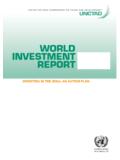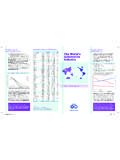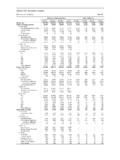Transcription of 1405-1255596 Global Wealth and Asset …
1 Global Wealth and Asset management industry outlook 1| Global Wealth and Asset management industry outlook 2014 ContentI. Executive summary II. Client view: once bitten, twice shyIII. Manufacturer view: differentiate and customize to surviveIV. Distributor view: the changing distribution equationV. Regulatory compliance: the era of big data and complex chaos VI. Outlook: expectations for the Global Wealth and Asset management industry 2 Global Wealth and Asset management industry outlook 2014 |3| Global Wealth and Asset management industry outlook 2014I. Executive summarySurvive, sustain, grow. That, in a nutshell, describes the Global Wealth and Asset management industry from the inception of the Global fi nancial crisis (GFC) through today.
2 4 Global Wealth and Asset management industry outlook 2014 |Mutual fund assets worldwide reached an all-time high at the end of 2013, due primarily to strong capital appreciation in equity and balanced/mixed fund categoriesNorth America and Europe were the largest contributors to the growth in mutual fund assets in 2013 AUM size and assets (US$t)2007200820092010201120122013 Source: Investment Company Institute. 2013. 2013 Investment Company Fact Book: A Review of Trends and Activity in the Investment Company Industry. Washington, DC: Investment Company Institute. Available at : Investment Company Institute, Washington, DC. 2012. For the most up-to-date fi gures about the fund industry, please visit = increase in AUMs from Q42012 to Q42013 Based on data for 46 countries; Asia fi gures exclude Hong Kong and SingaporeNorth AmericaUS$ +14.
3 7 %Latin AmericaUS$ $ $ $ +1 3 .9 %AsiaUS$ + | Global Wealth and Asset management industry outlook 2014 Through a macroeconomic lens, many Global equity indices in 2014 have hovered aroundall-time highs, suggesting that investors are strongly bullish about future corporate profi ts. Fixed income spreads have come off just marginally from their all-time lows, which typically implies that investors perceive substantially reduced levels of systemic risk and have little concern for infl ation. Real GDP growth rates (in %) * Kingdom * * : Business Monitor International*Estimated or forecasted valuesYet these market indicators and many others like them may be highly misleading. Traditional benchmarks of risk and investor sentiment, such as spreads to treasuries and Libor or equity indices, have lost a great deal of credibility.
4 Despite bullish capital markets and record fl ows into the industry, there remains deep uncertainty about Global systemic risk and continued shaky confi dence in investment managers. The promise of performance has not been kept, and investors, both institutional and retail, are demanding more for Wealth and Asset management industry outlook 2014 |While the largest bulge-bracket Asset managers have resumed impressive top-line growth in assets under management (AUM), margins have shrunk. With substantial fl ows going to less profi table passive products and exchange-traded funds (ETFs), increased Global competition for new AUM and ongoing tumultuous changes affecting the entire industry notably, the implementation of a vastly complex new regulatory environment continue to put signifi cant pressure on margins and the ability to reinvest for growth in the foreseeable future.
5 160140120100806040200 Dow Jones US AMS&P 500 Corporate valuations in US Asset management sector have underperformed broader market since GFCR evenue margins have declined from the pre-crisis levels of ~ and have stabilized at ~ : Standard & Poor s Capital IQThe analysis covers 28 fi rms and US$ trillion in AUM (as at 31 December 2013), including 18 US Asset managers and 10 UK Asset : Standard & Poor s Capital marginsUS managersUK managersApr 08 Oct 08 Apr 09 Oct 09 Apr 10 Oct 10 Apr 11 Oct 11 Apr 12 Oct 12 Apr 13 Oct 13 Apr 147| Global Wealth and Asset management industry outlook 20148 Global Wealth and Asset management industry outlook 2014 |1. Permanent paradigm shift. Many basic axioms that governed investor behavior and the operation of the industry have long since been discredited.
6 Capital preservation has become the new mantra, particularly for the huge market of baby boomers entering retirement, as well as for institutions and government agencies managing their pensions. The bubble markets of the last decade are in the past and will not likely recur to the same extent in the near future. This means that double-digit investment returns will be exceedingly rare, and the traditional core markets of the US and EU may be approaching terminal mediocrity. Those fi rms that fail to adjust will face severe challenges to continued profi tability and growth. Under the new paradigm, success will be determined by how managers can solve several key challenges: Enhancing operational effi ciency Complying with the complex regulatory environment Changing customer expectations Evolving distribution relationships Establishing clear brand identity and unique differentiation 2.
7 Intense competition will result in more focus on transparency, convergence and costs. Information about markets and fund managers is now more transparent, resulting in investors who are far more interested in what they are charged for the risks taken and returns received. Convergence, or at least stronger interest, between traditional and alternative managers in the others products continues to gain momentum as manufacturers seek to leverage their brand identity and distribution channels in a cost-effi cient drive to enhance revenues and grow AUM. And, closet beta products (active funds that do little more than deliver beta) will become increasingly diffi cult to sell when beta can be purchased nearly for free from passive funds and ETFs.
8 3. The years of regulatory compliance. Similar to the regulatory revolution that reshaped the airline and telecommunication industries in the 1980s and 1990s and rewrote the list of winners, new compliance requirements will likely be a game-changer for Asset managers. The reporting infrastructure that many fi rms even mid-sized players had in place before the fi nancial crisis is insuffi cient to effectively handle the complexity of reporting and data analysis required in the new regulatory environment. Traditionally viewed in the pre-crisis era as back-offi ce non-core functionality, compliance has now taken center stage in the C-suite as a core priority. This time around, the key to winning in the new regulatory environment will be integrated operational control and cost management gained by meeting the challenge of big data: successful implementation of a highly cost-effective, fl exible data platform making the entire reporting process automated, effi cient and scalable.
9 Particularly in Wealth management , client data will soon emerge as a core fi rm Asset , rather than a merely marginalized back-offi ce functionality. 4. Concentrate on core competencies. Core functionalities of most Asset management fi rms encompass business development, portfolio management , client service and, more recently, compliance. Outside of these key areas, most non-core functionalities will come under review for outsourcing, offshoring, shared service solutions or, at the very least, cost cutting and downsizing, in favor of the implementation of technology-supported process improvement. Aggressive cost management no different from standard management practices in the airline, fast food or hardline retail industry is the new Investor relationships and reliance on distribution partners.
10 Manufacturers of investment products are unique in two regards. First, they generally don t control their own direct client relationships but, instead, work substantially through distributors ( , registered investment advisors (RIAs), platforms, consultants, wire houses, private bankers). Second, while online and major big box retailing giants continue to break the rules of retailing and practically reinvent their business models every few years, most Asset managers have been resistant to change. They have manufactured more or less the same types of products and distributed them in more or less the same way for decades. Success in the post-crisis era will depend on offering new, more customized products to meet the needs of investors increasingly focused on capital preservation.










